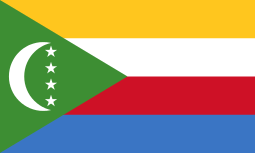Star and crescent
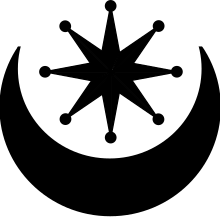

The star and crescent develops in the iconography of the Hellenistic period in Pontus, the Bosporan Kingdom, and notably Byzantium by the 2nd century BC. It is the conjoined representation of the crescent and a star, both of which constituent elements have a long prior history in the iconography of the Ancient Near East as representing either Sun and Moon, or Moon and Evening Star (or their divine personifications). Coins with crescent and star symbols represented separately have a longer history, with possible ties to older Mesopotamian iconography. The star or Sun is often shown within the arc of the crescent (also called star in crescent or star within crescent for disambiguation of depictions of a star and a crescent side by side);[1] In numismatics in particular, the term crescent and pellet is used in cases where the star is simplified to a single dot.[2]
In Byzantium, the symbol became associated its patron goddess Artemis-Hecate, and it is used as a representation of Moon goddesses (Selene-Luna or Artemis-Diana) in the Roman era. Ancient depictions of the symbol always show the crescent with horns pointing upward, and with the star (often with eight rays) placed inside the crescent. This arrangement is also found on Sassanid coins beginning in the 5th or 6th century.
The combination is found comparatively rarely in late medieval and early modern heraldry. It rose to prominence with its adoption as the flag and emblem of the Ottoman Empire in the 19th-century Westernizing tanzimat (reforms). The Ottoman flag of 1844 with a white ay-yıldız (Turkish for "crescent-star") on a red background continues to be in use as the flag of the Republic of Turkey with minor modifications. Other states formerly part of the Ottoman Empire also used the symbol, including Libya (1951–1969 and after 2011), Tunisia (1956) and Algeria (1958). The same symbol was used in other national flags introduced during the 20th century, including the flags of Azerbaijan (1918), Pakistan (1947), Malaysia (1948), Singapore (1959) and Mauritania (1959).
In the later 20th century, the star and crescent have acquired a popular interpretation as a "symbol of Islam",[3] occasionally embraced by Arab nationalism or Islamism in the 1970s to 1980s, but often rejected as erroneous or unfounded by Muslim commentators in more recent times.[4]
Unicode introduced a "star and crescent" character in its Miscellaneous Symbols block, at U+262A (☪).
History
Origins and predecessors


Crescents appearing together with a star or stars are a common feature of Sumerian iconography, the crescent usually being associated with the moon god Sin (Nanna) and the star with Ishtar (Inanna, i.e. Venus), often placed alongside the sun disk of Shamash.[6][7] In Late Bronze Age Canaan, star and crescent moon motifs are also found on Moabite name seals.[8]
|
|
|
|
|
|
The depiction of the crescent-and-star or "star inside crescent" as it would later develop in Bosporan Kingdom is difficult to trace to Mesopotamian art. Exceptionally, a combination of the crescent of Sin with the five-pointed star of Ishtar, with the star placed inside the crescent as in the later Hellenistic-era symbol, placed among numerous other symbols, is found in a boundary stone of Nebuchadnezzar I (12th century BC; found in Nippur by John Henry Haynes in 1896).[10] An example of such an arrangement is also found in the (highly speculative) reconstruction of a fragmentary stele of Ur-Nammu (Third Dynasty of Ur) discovered in the 1920s.[11]
Classical Antiquity
Hellenistic era
Mithradates VI Eupator of Pontus (r. 120–63 BC) used an eight rayed star with a crescent moon as his emblem. McGing (1986) notes the association of the star and crescent with Mithradates VI, discussing its appearance on his coins, and its survival in the coins of the Bosporan Kingdom where "[t]he star and crescent appear on Pontic royal coins from the time of Mithradates III and seem to have had oriental significance as a dynastic badge of the Mithridatic family, or the arms of the country of Pontus."[12] Several possible interpretations of the emblem have been proposed. In most of these, the "star" is taken to represent the Sun. The combination of the two symbols has been taken as representing Sun and Moon (and by extension Day and Night), the Zoroastrian Mah and Mithra,[13] or deities arising from Greek-Anatolian-Iranian syncretism, the crescent representing Mēn Pharnakou (Μήν Φαρνακου, the local moon god[14]) and the "star" (Sun) representing Ahuramazda (in interpretatio graeca called Zeus Stratios)[15][16]
By the late Hellenistic or early Roman period, the star and crescent motif had been associated to some degree with Byzantium. If any goddess had a connection with the walls in Constantinople, it was Hecate. Hecate had a cult in Byzantium from the time of its founding. Like Byzas in one legend, she had her origins in Thrace. Hecate was considered the patron goddess of Byzantium because she was said to have saved the city from an attack by Philip of Macedon in 340 BC by the appearance of a bright light in the sky. To commemorate the event the Byzantines erected a statue of the goddess known as the Lampadephoros ("light-bearer" or "light-bringer").[17]
Some Byzantine coins of the 1st century BC and later show the head of Artemis with bow and quiver, and feature a crescent with what appears to be a six-rayed star on the reverse.
-
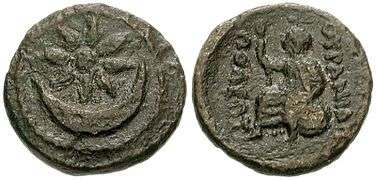
Star and crescent on a coin of Uranopolis, Macedon, ca. 300 BC (see also Argead star).
-
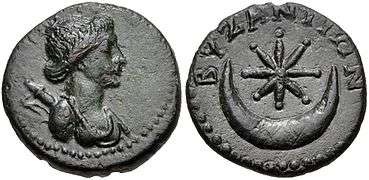
Byzantine coin (1st century) with a bust of Artemis on the obverse and an eight-rayed star within a crescent on the reverse side.
- ^ H. G. Liddell, A History of Rome from the earliest times to the establishment of the Empire (1857), p. 605. C.f. forumancientcoins.com.
Persia
The star and crescent symbol appears on some coins of the Parthan vassal kingdom of Elymais in the late 1st century AD. The same symbol is present in coins that are possibly associated with Orodes I of Parthia (1st century BC). In the 2nd century AD, some Parthian coins show a simplified "pellet within crescent" symbol.[18]
-
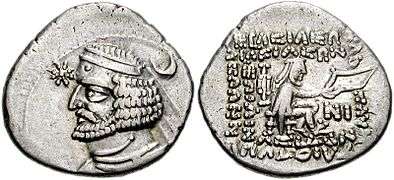
A star and a crescent appearing (separately) on the obverse side of a coin of Orodes II of Parthia (r. 57–37 BC).
-

Coin of Phraates V of Parthia (r. c. 2 BC to AD 4)
-
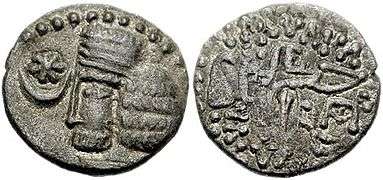
Coin of Vardanes I of Parthia (r. c. AD 40–45)
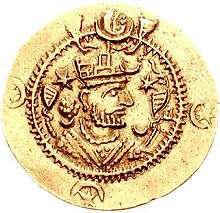
The star and crescent motif appears on the margin of Sassanid coins in the 5th century.[19] Sassanid rulers also appear to have used crowns featuring a crescent, sphere and crescent, or star and crescent.
Use of the star-and-crescent combination apparently goes back to the earlier appearance of a star and a crescent on Parthian coins, first under under king Orodes II (1st century BC). In these coins, the two symbols occur separately, on either side of the king's head, and not yet in their combined star-and-crescent form. Such coins are also found further afield in Greater Persia, by the end of the 1st century AD in a coin issues by the Western Satraps ruler Chashtana.[20] This arrangement is likely inherited from its Ancient Near Eastern predecessors; the star and crescent symbols are not frequently found in Achaemenid iconography, but they are present in some cylinder seals of the Achaemenid era.[21]
Ayatollahi (2003) attempts to connect the modern adoption as an "Islamic symbol" to Sassanid coins remaining in circulation after the Islamic conquest [22] although there is no evidence for any connection of the symbol with Islam or the Ottomans prior to its adoption in Ottoman flags in the late 18th century.[23]
Roman Empire
In the 2nd century, the star-within-crescent is found on the obverse side of Roman coins minted during the rule of Hadrian, Geta, Caracalla and Septimius Severus, in some cases as part of an arrangement of a crescent and seven stars, one or several of which were placed inside the crescent.[24]
-
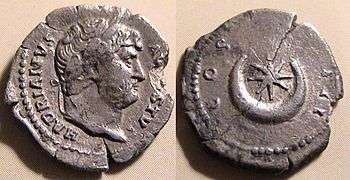
Coin of Roman Emperor Hadrian (r. 117–138). The reverse shows an eight-rayed star within a crescent.
-
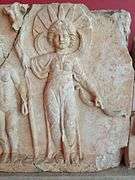
Roman period limestone pediment from Perge, Turkey (Antalya Museum) showing Diana-Artemis with a crescent and a radiant crown.
Medieval and early modern
Classical heraldry
The crescent on its own is used in western heraldry from at least the 13th century, while the star and crescent (or "Sun and Moon") emblem is in use in medieval seals at least from the late 12th century. The crescent in pellet symbol is used in Crusader coins of the 12th century, in some cases duplicated in the four corners of a cross, as a variant of the cross-and-crosslets ("Jerusalem cross").[25] Many Crusader seals and coins show the crescent and the star (or blazing Sun) on either side of the ruler's head (as in the Sassanid tradition), e.g. Bohemond III of Antioch, Richard I of England, Raymond VI, Count of Toulouse.[26] At the same time, the star in crescent is found on the obverse of Crusader coins, e.g. in coins of the County of Tripoli minted under Raymond II or III c. 1140s–1160s show an "eight-rayed star with pellets above crescent".[27]
The star and crescent combination appears in attributed arms from the early 14th century, possibly in a coat of arms of c. 1330, possibly attributed to John Chrysostom,[28] and in the Wernigeroder Wappenbuch (late 15th century) attributed to one of the three Magi, named "Balthasar of Tarsus".[29]
In Roman Catholic iconography, the Virgin Mary is associated with both stars and crescent in her representation as the Woman of the Apocalypse, "clothed with the sun, and the moon under her feet, and upon her head a crown of twelve stars".[30]
Crescents (without the star) increase in popularity in early modern heraldry in Europe. Siebmachers Wappenbuch (1605) records 48 coats of arms of German families which include one or several crescents.[31]
The star and crescent combination remains rare prior to its adoption by the Ottoman Empire in the second half of the 18th century. In the late 16th century, the Korenić-Neorić Armorial shows a white star and crescent on a red field as the coat of arms of Illyria.
-
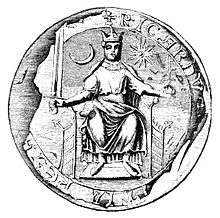
Great Seal of Richard I of England (1198)[1]
-

Equestrian seal of Raymond VI, Count of Toulouse with a star and a crescent (13th century)
-
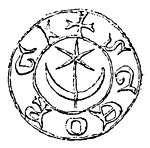
The Polish Leliwa coat of arms (14th-century seal)
-
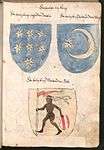
Coats of arms of the Three Magi, with "Baltasar of Tarsus" being attributed a star and crescent increscent in a blue field, Wernigerode Armorial (c. 1490)
-

Coat of arms of John Freigraf of "Lesser Egypt" (i.e. Romani/gypsy),[3] 18th-century drawing of a 1498 coat of arms in Pforzheim church.
-
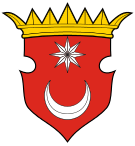
The coat of arms of "Illyria" from the Korenić-Neorić Armorial (1590s)
-

Star and crescent on the obverse of the Jelacic-Gulden of the Kingdom of Croatia (1848)
- ^ Richard is depicted as seated between a crescent and a "Sun full radiant" in his second Great Seal of 1198. English heraldic tradition of the early modern period associates the star and crescent design with Richard, with his victory over Isaac Komnenos of Cyprus in 1192, and with the arms of Portsmouth (Francis Wise A Letter to Dr Mead Concerning Some Antiquities in Berkshire, 1738, p. 18). Heraldic tradition also attributes a star-and-crescent badge to Richard (Charles Fox-Davies, A Complete Guide to Heraldry, 1909, p. 468).
- ^ Found in the 19th century at the site of the Biais commandery, in Saint-Père-en-Retz, Loire-Atlantique, France, now in the Musée Dobré in Nantes, inv. no. 303. Philippe Josserand, "Les Templiers en Bretagne au Moyen Âge : mythes et réalités", Annales de Bretagne et des Pays de l’Ouest 119.4 (2012), 7–33 (p.24).
- ^ In 15th-century Europe, it was widely assumed that the gypsies were Egyptians (hence the name gypsies), and several gypsy leaders are known to have styled themselves as "counts of lesser Egypt". Wilhelm Ferdinand Bischoff, Deutsch-Zigeunerisches Wörterbuch (1827), p.14
Islamic usage
While the crescent on its own is depicted as an emblem used on Islamic war flags from the medieval period, at least from the 13th century although it does not seem to have been in frequent use until the 14th or 15th century,[32] the star and crescent in an Islamic context is more rare in the medieval period, but may occasionally be found in depictions of flags from the 14th century onward.
Some Mughal era (17th century) round shields were decorated with a crescent or star and crescent.
-

Depiction of a star and crescent flag on the Saracen side in the Battle of Yarmouk (manuscript illustration of the History of the Tatars, Catalonian workshop, early 14th century).
-

A miniature painting from a Padshahnama manuscript (c. 1640), depicting Mughal Emperor Shah Jahan as bearing a shield with a star and crescent decoration.
-
_facing_a_maddened_elephant_named_Sudhakar_(7_June_1633).jpg)
A painting from a Padshahnama manuscript (1633) depicts the scene of Aurangzeb facing the maddened War elephant Sudhakar. Sowar's shield is decorated with a star and crescent.
Use in the Ottoman Empire

The adoption of star and crescent as the Ottoman state symbol started during the reign of Mustafa III (1757–1774) and its use became well-established during Abdul Hamid I (1774–1789) and Selim III (1789–1807) periods.[33] A buyruldu from 1793 states that the ships in the Ottoman navy have that flag, and various other documents from earlier and later years mention its use.[33] The ultimate source of the emblem is unclear. It is mostly derived from the star-and-crescent symbol used by the city of Constantinople in antiquity, possibly by association with the crescent design (without star) used in Turkish flags since before 1453.[34]
With the Tanzimat reforms in the 19th century, flags were redesigned in the style of the European armies of the day. The flag of the Ottoman Navy was made red, as red was to be the flag of secular institutions and green of religious ones. As the reforms abolished all the various flags (standards) of the Ottoman pashaliks, beyliks and emirates, a single new Ottoman national flag was designed to replace them. The result was the red flag with the white crescent moon and star, which is the precursor to the modern flag of Turkey. A plain red flag was introduced as the civil ensign for all Ottoman subjects. The white crescent with an eight-pointed star on a red field is depicted as the flag of a "Turkish Man of War" in Colton's Delineation of Flags of All Nations (1862). Steenbergen's Vlaggen van alle Natiën of the same year shows a six-pointed star. A plate in Webster's Unabridged of 1882 shows the flag with an eight-pointed star labelled "Turkey, Man of war". The five-pointed star seems to have been present alongside these variants from at least 1857.
In the late 19th century, "Star and Crescent" came to be used as a metaphor for Ottoman rule in British literature.[35] The increasingly ubiquitous fashion of using the star and crescent symbol in the ornamentation of Ottoman mosques and minarets led to a gradual association of the symbol with Islam in general in western Orientalism.[36] The "Red Crescent" emblem was used by volunteers of the International Committee of the Red Cross (ICRC) as early as 1877 during the Russo-Turkish War; it was officially adopted in 1929.
After the foundation of the Republic of Turkey in 1923, the new Turkish state maintained the last flag of the Ottoman Empire. Proportional standardisations were introduced in the Turkish Flag Law (Turkish: Türk Bayrağı Kanunu) of May 29, 1936. Besides the most prominent example of Turkey (see Flag of Turkey), a number of other Ottoman successor states adopted the design during the 20th century, including the Emirate of Cyrenaica and the Kingdom of Libya, Algeria, Tunisia, and the proposed Arab Islamic Republic.
Contemporary use
State flags
The Ottoman flag of 1844 with a white "ay-yıldız" (Turkish for "crescent-star") on a red background continues to be in use as the flag of the Republic of Turkey with minor modifications.
Other Ottoman successor states using the star and crescent design in their flag are Tunisia (1956) and Algeria (1958). The modern emblem of Turkey shows the star outside the arc of the crescent, as it were a "realistic" depiction of a conjunction of Moon and Venus, while in the 19th century, the Ottoman star and crescent was occasionally still drawn as the (classical but "astronomically incorrect") star-within-crescent. By contrast, the designs of both the flags of Algeria and Tunisia (as well as Mauritania and Pakistan) place the star within the crescent.
The same symbol was used in other national flags introduced during the 20th century, including the flags of Azerbaijan (1918, re-introduced 1991), Pakistan (1947), Malaysia (1948), Libya (1951, re-introduced 2011), Mauritania (1959), and the partially recognized states of the Sahrawi Arab Democratic Republic (1976) and Northern Cyrus (1983).
Some flags also use the same star and crescent symbol but with more than one star.
Symbol of Islam
By the mid 20th century, the symbol came to be re-interpreted as the symbol of Islam or the Muslim community.[37] This symbolism was embraced by movements of Arab nationalism or Islamism in the 1970s, such as the proposed Arab Islamic Republic (1974) and the American Nation of Islam (1973).[38]
Cyril Glassé in his The New Encyclopedia of Islam (2001 edition, s.v. "Moon") states that "in the language of conventional symbols, the crescent and star have become the symbols of Islam as much as the cross is the symbol of Christianity."[3] By contrast, some religious Islamic publications emphasize that the crescent is rejected "by many Muslim scholars".[4]
Municipal coats of arms
The star and crescent is also found in a number of municipal coats of arms (mostly derived from early modern heraldry without any connection to the Ottoman use of the symbol, in the case of Polish municipality based on the Leliwa (Tarnowski) coat of arms).
-
.svg.png)
Coat of arms of Halle an der Saale, Germany (1327).
-
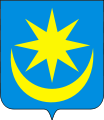
Coat of arms of Mińsk Mazowiecki, Poland.
-

Coat of arms of Przeworsk, Poland.
-

Coat of arms of Tarnobrzeg, Poland.
-

Coat of arms of Tarnów, Poland.
-
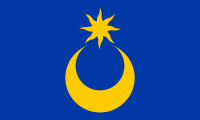
Flag of Portsmouth, England (17th century).
-

Coat of arms of Mattighofen, Austria (1781)
-

Coat of arms of Oelde, Germany (1910).
-

Coat of arms of Niederglatt, Switzerland (1928)[1]
-
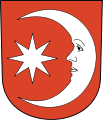
Coat of arms of Niederweningen, Switzerland (1928)[1]
-
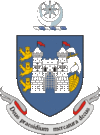
Coat of arms of Drogheda, Ireland
References
| Wikimedia Commons has media related to Star and crescent. |
| Look up ☪ in Wiktionary, the free dictionary. |
- ↑ "There are also three cases [... viz., associated with the "Danubian Rider Religion"] where the star, figured as a radiate disc 'balancing the crescent moon', must represent Sol, balancing Luna who is represented as a crescent instead of in bust. The 'star in crescent' theme itself appears only once, on an engraved gem, accompanied by the lion and an indecipherable inscription [...] This theme is connected with the Orient and has a long history behind it in the Hittite, Babylonian, Assyrian, Sassanid and Iranian worlds. Campbell gives us valuable particulars. The heavenly bodies thus symbolized were seen as the powerful influence of cosmic fatalism guiding the destinies of men." Dumitru Tudor, Christopher Holme (trans.), Corpus Monumentorum Religionis Equitum Danuvinorum (CMRED) (1976), p. 192 (referencing Leroy A. Campbell, Mithraic Iconography and Ideology' '(1969), 93f.
- ↑ e.g. Catalogue of the Greek coins in The British Museum (2005), p. 311 (index).
- 1 2 Cyril Glassé , The New Encyclopedia of Islam (revised ed. 2001), s.v. "Moon" (p. 314).
- 1 2 "many Muslim scholars reject using the crescent moon as a symbol of Islam. The faith of Islam historically had no symbol, and many refuse to accept it." Fiaz Fazli, Crescent magazine, Srinagar, September 2009, p. 42.
- ↑ A similar stele found in Babylon is kept in the British Museum (no. 90837).
- ↑ Michael R. Molnar, The Star of Bethlehem, Rutgers University Press, 1999, p78
- ↑ "the three celestial emblems, the sun disk of Shamash (Utu to the Sumerians), the crescent of Sin (Nanna), and the star of Ishtar (Inanna to the Sumerians)" Irving L. Finkel, Markham J. Geller, Sumerian Gods and Their Representations, Styx, 1997, p71. André Parrot, Sumer: The Dawn of Art, Golden Press, 1961
- ↑ Othmar Keel, Christoph Uehlinger, Gods, Goddesses, and Images of God in Ancient Israel, Fortress Press, 1998, p. 322.
- ↑ A.H. Gardiner, Egyptian Grammar: Being an Introduction to the Study of Hieroglyphs. 3rd Ed., pub. Griffith Institute, Oxford, 1957 (1st edition 1927), p. 486.
- ↑ W. J. Hinke, A New Boundary Stone of Nebuchadrezzar I from Nippur with a Concordance of Proper Names and a Glossary of the Kudurru Inscriptions thus far Published (1907), 120f. University of Pennsylvania Museum of Archaeology and Anthropology, object nr. 29-20-1.
- ↑ J. V. Canby, Reconstructing the Ur Nammu Stela, Expedition 29.1, 54–64.
- ↑ B.C. McGing, The Foreign Policy of Mithradates VI Eupator, King of Pontus, Brill, 1986, p 97
- ↑ ""The star and the crescent, the emblem of the Pontus and its kings, were introduced by Mithradates and his successors to the Bosporus and appeared on Bosporan coins and locally produced jewelry. On the coins this symbol often appears near the head of a young man wearing a Phrygian cap, who is identified as either a solar deity or his deified worshipper. [...] the star and the crescent, the badge of the Pontus and its kings, shown on the Colchian amphora stamp, and appearing on engraved finger-rings discovered in this area allude to the possibility of an earlier association of the Pontic dynasty with the cult of mounted Mithra. Mithra in fact must have been one of the most venerated gods of the Pontic Kingdom, since its rulers bore the theoporic name of Mithradates [...] although direct evidence for this cult is rather meager." Yulia Ustinova, The Supreme Gods of the Bosporan Kingdom, Brill, 1998, 270–274
- ↑ Strabo (12.3.31) writes that Mēn Pharnakou had a sancturay at Kabeira in Pontus where the Pontic kings would swear oaths. Mēn Pharnakou is a syncretistic Anatolian-Iranian moon deity not directly comparable to Zoroastrian Māh. Albert F. de Jong, Traditions of the Magi: Zoroastrianism in Greek and Latin Literature (1997), %A9n%20Pharmakou&f=false p. 306.
- ↑ "His royal emblem, an eight rayed star and the crescent moon, represented the dynasty's patron gods, Zeus Stratios, or Ahuramazda, and Mén Pharnakou, a Persian form of the native moon goddess." Andrew G. Traver, From Polis to Empire—The Ancient World c. 800 B.C.–A.D. 450, Greenwood Publishing Group, 2002, p. 257
- ↑ "The significance of the star and crescent on royal coins has also been frequently debated. Many scholars have identified the star and the crescent as royal symbols of the Pontic kingdom. Their appearance on every royal issue suggests they were indeed important symbols, and the connection of this symbol to the royal family is definite. The nature of it, however, is still uncertain. Kleiner believed they were symbols of an indigenous god and had their origins in Persia. He associated the star and crescent with the god Men and saw them as representations of night and day (the star may be considered the sun here). Ritter, on the other hand, suggested that the star and crescent symbols derived from Perseus, just as the star symbol of the Macedonians did. […] Ma and Mithras are two other deities with whom the star and crescent symbol are associated. Olshausen believed that the star and crescent could be related to a syncretism of Pontic and Iranian iconography: the crescent for Men and the star for Ahura Mazda. Recently, Summerer has convincingly suggested that Men alone was the inspiration for the symbol on the royal coins of the Pontic kingdom. Deniz Burcu Erciyas, "Wealth, Aristocracy, and Royal Propaganda Under The Hellenistic Kingdom of The Mithradatids in The Central Black Sea Region in Turkey", Colloquia Pontica Vol.12, Brill, 2005, p 131
- ↑ "Devotion to Hecate was especially favored by the Byzantines for her aid in having protected them from the incursions of Philip of Macedon. Her symbols were the crescent and star, and the walls of her city were her provenance." Vasiliki Limberis, Divine Heiress, Routledge, 1994, p 15. "In 340 B.C., however, the Byzantines, with the aid of the Athenians, withstood a siege successfully, an occurrence the more remarkable as they were attacked by the greatest general of the age, Philip of Macedon. In the course of this beleaguerment, it is related, on a certain wet and moonless night the enemy attempted a surprise, but were foiled by reason of a bright light which, appearing suddenly in the heavens, startled all the dogs in the town and thus roused the garrison to a sense of their danger. To commemorate this timely phenomenon, which was attributed to Hecate, they erected a public statue to that goddess [...]" William Gordon Holmes, The Age of Justinian and Theodora, 2003 p 5-6; "If any goddess had a connection with the walls in Constantinople, it was Hecate. Hecate had a cult in Byzantium from the time of its founding. Like Byzas in one legend, she had her origins in Thrace. Since Hecate was the guardian of "liminal places", in Byzantium small temples in her honor were placed close to the gates of the city. Hecate's importance to Byzantium was above all as deity of protection. When Philip of Macedon was about to attack the city, according to the legend she alerted the townspeople with her ever-present torches, and with her pack of dogs, which served as her constant companions. Her mythic qualities thenceforth forever entered the fabric of Byzantine history. A statue known as the 'Lampadephoros' was erected on the hill above the Bosphorous to commemorate Hecate's defensive aid." Vasiliki Limberis, Divine Heiress, Routledge, 1994, p 126-127. This story survived in the works , who in all probability lived in the time of Justinian I. His works survive only in fragments preserved in Photius and the 10th century lexicographer Suidas. The tale is also related by Stephanus of Byzantium, and Eustathius.
- ↑ Michael Alram, Nomina Propria Iranica in Nummis, Materialgrundlagen zu den iranischen Personennamen auf Antiken Münzen (1986); C. Augé, "Quelques monnaies d'Elymaïde," Bulletin de la Société Française de Numismatique, November 1976; N. Renaud, "Un nouveau souverain d'Elymaïde," Bulletin de la Société Française de Numismatique, January 1999, pp. 1-5. Coins of Elymais (parthia.com).
- ↑ "The star and crescent are common Persian symbols, being a regular feature of the borders of Sassanian dirhems." Philip Grierson, Byzantine Coins, Taylor & Francis, 1982, p118
- ↑ "A rare type with crescent and star alone on the reverse is probably Chashtana's earliest issue, struck before he extended his power into Malwa." H.H. Dodwell (Ed.), The Cambridge Shorter History of India, Cambridge University Press, 1935, p. 83.
- ↑ Achaemenid period: "not normally associated with scenes cut in the Court Style"; Persepolis seal PFS 71 (M. B. Garrison in Curtis and Simpson (eds.), The World of Achaemenid Persia: History, Art and Society in Iran and the Ancient Near East (2010), p. 354) PFS 9 (M. B. Garrison, Seals And The Elite At Persepolis; Some Observations On Early Achaemenid Persian Art (1991), p. 8). Parthian period: "[t]he Parthian king Mithradates I conquered Mesopotamia around 147 BC, and Susa in about 140 BC A later Parthian king, Orodes II (58-38 BC), issued coins at Susa and elsewhere which display a star and crescent on the obverse. The succeeding ruler, Phraates IV (38-3/2 BC), minted coins showing either a star alone or a star with crescent moon. In representing the star and crescent on their coins the Parthians thus adopted traditional symbols used in Mesopotamia and Elam more than two millennia before their own arrival in those parts." John Hansman, "The great gods of Elymais" in Acta Iranica, Encyclopédie Permanente Des Etudes Iraniennes, v.X, Papers in Honor of Professor Mary Boyce, Brill Archive, 1985, pp 229–232
- ↑ "Sasani coins remained in circulation in Moslem countries up to the end of the first century (Hijra). This detailed description of Sasani crowns was presented because the motifs mentioned, particularly the crescent and star gradually changed into Islamic symbols and have often appeared in the decorative patterns of various periods of Islamic art. [...] The flags of many Islamic countries bear crescents and stars and are proof of this Sasani innovation." Habibollah Ayatollahi (trans. Shermin Haghshenās), The Book of Iran: The History of Iranian Art, Alhoda UK, 2003, pp 155–157
- ↑ "when we come to examine the history of the crescent as a badge of Muhammadanism, we are confronted by the fact that it was not employed by the Arabs or any of the first peoples who embraced the faith of the prophet" "The truth is that the crescent was not identified with Islam until after the appearance of the Osmanli Turks, whilst on the other hand there is the clearest evidence that in the time of the Crusades, and long before, the crescent and star were a regular badge of Byzantium and the Byzantine Emperors, some of whom placed it on their coins." William Ridgeway, "The Origin of the Turkish Crescent", in The Journal of the Royal Anthropological Institute of Great Britain and Ireland, Vol. 38 (Jul. - Dec. 1908), pp. 241-258 (p 241)
- ↑ Selene and Luna on Roman Coins (forumancientcoins.com): "Bronze coin of Caracalla from Nicopolis ad Istrum with a single star in the arms of the crescent moon; coin of Geta showing five stars; a denarius of Septimius Severus with an array of seven stars." Roman-era coins from Carrhae (Harran): Carrhae, Mesopotamia, modern day Harran (wildwinds.com)
- ↑ In the 12th century found on pennies William The Lion (r. 1174–1195). William Till, An Essay on the Roman Denarius and English Silver Penny (1838), p. 73. E.g. "Rev: short cross with crescent and pellets in angles and +RAVLD[ ] legend for the moneyer Raul Derling at Berwick or Roxburgh mint" (timelineauctions.com). Seaby SE5025 "Rev. [+RAV]L ON ROC, short cross with crescents & pellets in quarters" (wildwinds.com).
- ↑ Bohemond III of Antioch (r. 1163–1201) "Obv. Helmeted head of king in chain-maille armor, crescent and star to sides" (ancientresource.com)
- ↑ "Billon denier, struck c. late 1140s-1164. + RA[M]VNDVS COMS, cross pattée, pellet in 1st and 2nd quarters / CIVI[TAS T]RIPOLIS, eight-rayed star with pellets above crescent. ref: CCS 6-8; Metcalf 509 (ancientresource.com).
- ↑ "The earliest church in the Morea to include a saint holding a shield marked by the crescent and star may be St. John Chrysostom, which has been dated on the basis of style to ca. 1300 [...]" Angeliki E. Laiou, Roy P. Mottahedeh, The Crusades From the Perspective of Byzantium and the Muslim World, Dumbarton Oaks, 2001, p 278
- ↑ p. 21; adopted by Virgil Solis in his Wappenbüchlein (1555)
- ↑ A. Baring and J. Cashford, The Myth of the Goddess: Evolution of an Image, Penguin UK (1993); c.f. K. Tate, Sacred Places of Goddess: 108 Destinations (2005), p. 144.
- ↑ Sara L. Uckelman, An Ordinary of Siebmacher's Wappenbuch (ellipsis.cx) (2014)
- ↑ Pamela Berger, The Crescent on the Temple: The Dome of the Rock as Image of the Ancient Jewish Sanctuary (2012), p. 164f
- 1 2 İslâm Ansiklopedisi (in Turkish). 4. Istanbul: Türkiye Diyanet Vakfı. 1991. p. 298.
- ↑ "It seems possible, though not certain, that after the conquest Mehmed took over the crescent and star as an emblem of sovereignty from the Byzantines. The half-moon alone on a blood red flag, allegedly conferred on the Janissaries by Emir Orhan, was much older, as is demonstrated by numerous references to it dating from before 1453. But since these flags lack the star, which along with the half-moon is to be found on Sassanid and Byzantine municipal coins, it may be regarded as an innovation of Mehmed. It seems certain that in the interior of Asia tribes of Turkish nomads had been using the half-moon alone as an emblem for some time past, but it is equally certain that crescent and star together are attested only for a much later period. There is good reason to believe that old Turkish and Byzantine traditions were combined in the emblem of Ottoman and, much later, present-day Republican Turkish sovereignty." Franz Babinger (William C. Hickman Ed., Ralph Manheim Trans.), Mehmed the Conqueror and His Time, Princeton University Press, 1992, p 108
- ↑ e.g. A. Locher, "With Star and Crescent: A Full and Authentic Account of a Recent Journey with a Caravan from Bombay to Constantinope"; Andrew Haggard, "Under Crescent and Star" (1895).
- ↑ "Mosque and minaret are surmounted by crescents; the air glowing over the Golden Horn is, as it were, full of moons." Hezekiah Butterworth, Zigzag journeys in the Orient vol. 3 (1882), p. 481.
- ↑ The symbolism of the star and crescent in the flag of the Kingdom of Libya (1951–1969) was explained in an English language booklet, The Libyan Flag & The National Anthem, issued by the Ministry of Information and Guidance of the Kingdom of Libya (year unknown, cited after Jos Poels at FOTW, 1997) as follows: "The crescent is symbolic of the beginning of the lunar month according to the Muslim calendar. It brings back to our minds the story of Hijra (migration) of our Prophet Mohammed from his home in order to spread Islam and teach the principles of right and virtue. The Star represents our smiling hope, the beauty of aim and object and the light of our belief in God, in our country, its dignity and honour which illuminate our way and puts an end to darkness."
- ↑ Edward E. Curtis, Black Muslim religion in the Nation of Islam, 1960–1975 (2006), p. 157.
- Charles Boutell. "Device of Star (or Sun) and Crescent". In: The Gentleman's Magazine, Volume XXXVI (New Series). London: John Nicols & Son, London, 1851, pp. 514–515.
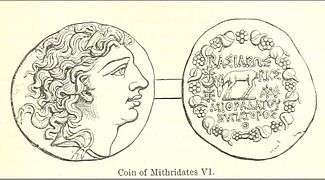








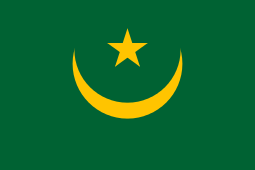
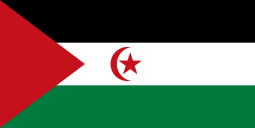
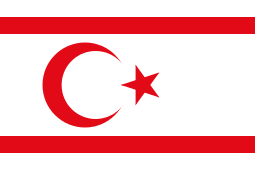
_Islands.svg.png)
